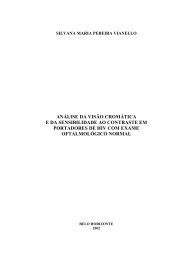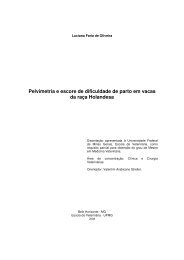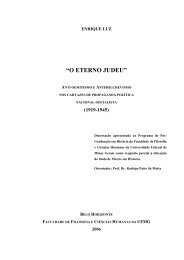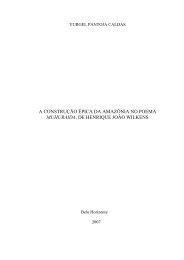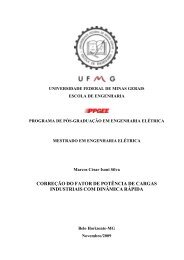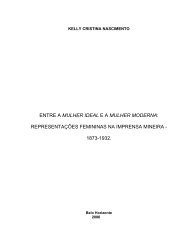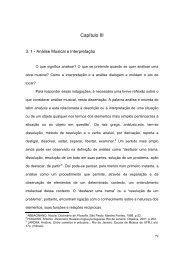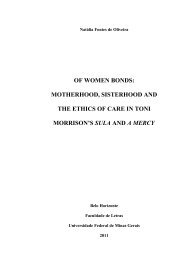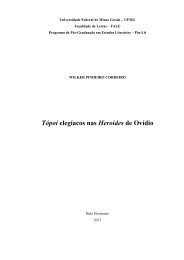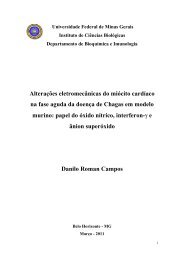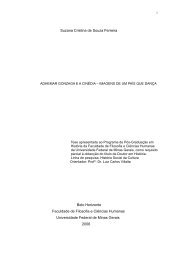- Page 1 and 2:
UFMG 737 T. 302 ANA PAULA FONSECA M
- Page 3 and 4:
O trabalho descrito nesta tese foi
- Page 5 and 6:
Agradecimentos À Deus por ter me d
- Page 7 and 8:
Sumário Sumário de Figuras.......
- Page 9 and 10:
2.4.4 Degradação do inseticida Me
- Page 11 and 12:
Sumário de Figuras Figura 1.1- Rep
- Page 13 and 14:
Figura 2.28- Degradação do inseti
- Page 15 and 16:
Figura 3.31 - ESI(-)-MS/MS para o
- Page 17 and 18:
Esquema 3.8 - Possíveis produtos f
- Page 19 and 20:
Tabela 2.9- Principais fragmentos g
- Page 21 and 22:
Mag - magnetita CI- ionização qu
- Page 23 and 24:
Abstract Firstly, the degradation o
- Page 25 and 26:
1. Introdução A contaminação do
- Page 27 and 28:
1.1.1 Sistema UV e UV/H2O2 Quando c
- Page 29 and 30:
R2C=CR2 + O3 → RCHO , R2CO, RCOOH
- Page 31 and 32:
heterogênea/ozônio, utilizando Ti
- Page 33 and 34:
Este processo tem sido aplicado na
- Page 35 and 36:
destacam-se a Espectrometria de Mas
- Page 37 and 38:
Assim como na ionização por elét
- Page 39 and 40:
processo de divisão continua até
- Page 41 and 42:
obter um espectro de massas resulta
- Page 43 and 44:
comprimentos da onda de luz branca
- Page 45 and 46:
Em geral, a Lei de Beer é aplicáv
- Page 47 and 48:
2.1 Introdução Com o objetivo de
- Page 49 and 50:
Figura 2.1 - Estrutura química da
- Page 51 and 52:
possível detectar a presença do i
- Page 53 and 54:
irritação da pele, dos olhos, do
- Page 55 and 56:
praticamente não ocorre degradaç
- Page 57 and 58:
2.3 Materiais e Métodos 2.3.1 Sín
- Page 59 and 60:
Sistema em meio ácido Num experime
- Page 61 and 62:
2.3.2.2 Inseticida Imidacloprid O3
- Page 63 and 64:
2.4.6 Análises de TOC Para se veri
- Page 65 and 66:
2.4 Resultados e Discussão 2.4.1 D
- Page 67 and 68:
Tomando como base a tabela 2.1, os
- Page 69 and 70:
Tabela 2.2 - Segundo Planejamento F
- Page 71 and 72:
degradação. A luz ultra-violeta
- Page 73 and 74:
Thiamethoxam. Apenas a radiação u
- Page 75 and 76:
(a) (b) Figura 2.11 - (a) Cromatogr
- Page 77 and 78:
2.4.1.2 Análise por Espectrometria
- Page 79 and 80:
Me Me N NO H + 2 N O N [1 + H] + m/
- Page 81 and 82:
Para a determinação da estrutura
- Page 83 and 84:
Abundância Relativa/ % 100 80 60 4
- Page 85 and 86:
Me Me H S + N N H H + O O O [4 + H]
- Page 87 and 88:
Na rota de degradação do Thiameth
- Page 89 and 90:
Concluindo, pode-se dizer que três
- Page 91 and 92:
Tabela 2.5- Resultados dos testes d
- Page 93 and 94:
12,9%, respectivamente. Além disso
- Page 95 and 96:
Figura 2.22- Gráfico de Pareto par
- Page 97 and 98:
m(Fe0 m(Fe /Fe3O4 ) 0 /Fe3O4 ) e m(
- Page 99 and 100:
C/C0 C/C0 1 0,8 0,6 0,4 0,2 0 0 6 1
- Page 101 and 102: Figura 2.25 - ESI(+)-MS da soluçã
- Page 103 and 104: ESI(+)-MS/MS. A seleção por massa
- Page 105 and 106: essonância com os elétrons não l
- Page 107 and 108: (2) foi degradado sob estas condiç
- Page 109 and 110: De acordo com os resultados, o meca
- Page 111 and 112: Figura 2.28- Degradação do inseti
- Page 113 and 114: 2.4.5 Análise de Carbono Orgânico
- Page 115 and 116: 3.1 Introdução Os corantes alimen
- Page 117 and 118: Sabe-se que entre os sistemas biol
- Page 119 and 120: Corantes Trifenilmetanos - Essa cla
- Page 121 and 122: provenientes da indústria têxtil
- Page 123 and 124: conseqüentemente, no mecanismo glo
- Page 125 and 126: A radiação ultra-violeta foi obti
- Page 127 and 128: 3.3.1 Degradação dos corantes Azo
- Page 129 and 130: que NaClO agiu mais rapidamente sob
- Page 131 and 132: Porcentagem de degradação (%) Ín
- Page 133 and 134: Figura 3.7 - Degradação do Índig
- Page 135 and 136: descoloração foi mais rápida uti
- Page 137 and 138: 3.3.4 Degradação do corante Eritr
- Page 139 and 140: Abs (normalizadas) Figura 3.15 - De
- Page 141 and 142: Como foi verificado, o tratamento c
- Page 143 and 144: - O3S - O3S N O H H N O 1 (m/z 210)
- Page 145 and 146: Figura 3.20 - ESI(-)-MS/MS para o
- Page 147 and 148: Informações sobre as estruturas d
- Page 149 and 150: Esquema 3.3 - Fragmentações suger
- Page 151: Esquema 3.4 - Rota proposta para a
- Page 155 and 156: Analogamente, o ânion de m/z 195 c
- Page 157 and 158: - O3S - O3S m/z 206 N N HO . não d
- Page 159 and 160: - O3S HO HO 2b m/z 159 não detecta
- Page 161 and 162: Abundância relativa/ % 100 80 60 4
- Page 163 and 164: Esquema 3.9 - Possíveis produtos f
- Page 165 and 166: 3.3.6- Teste de ecotoxicidade Uma e
- Page 167 and 168: Em relação aos produtos de degrad
- Page 169 and 170: Referências Bibliográficas 1 Pera
- Page 171 and 172: 30 Xuejun, LV. Yiming, Xu.; Kangle,
- Page 173 and 174: 55 Cienfuegos, F.; Vaitsman, D. An
- Page 175 and 176: 79 Tamimi, M.; Qourzal, S.; Assabba
- Page 177 and 178: 105 Ford, K.A.; Casida, J.E. Chem.
- Page 179: 131 Satoshihorikoshi, Aikosaitou, A



